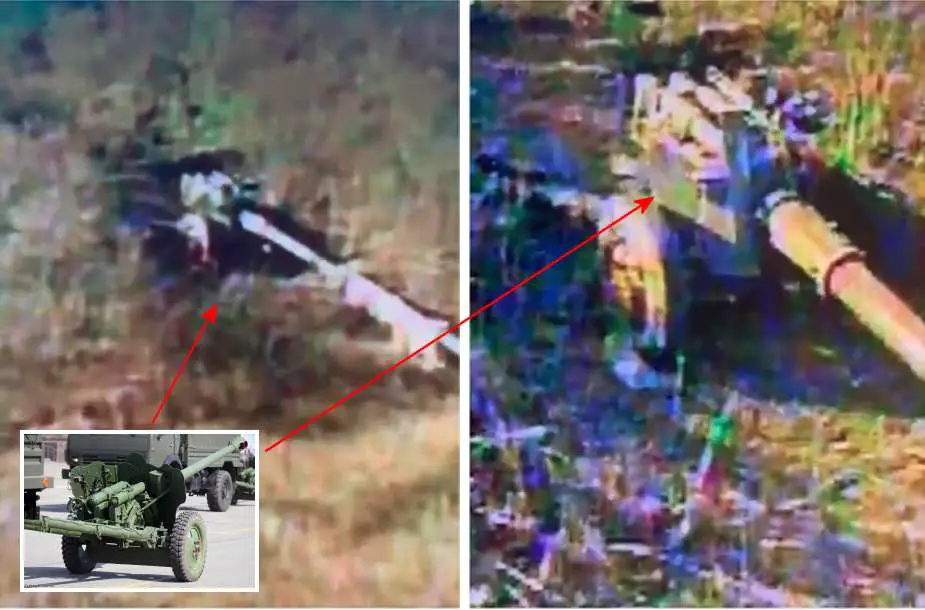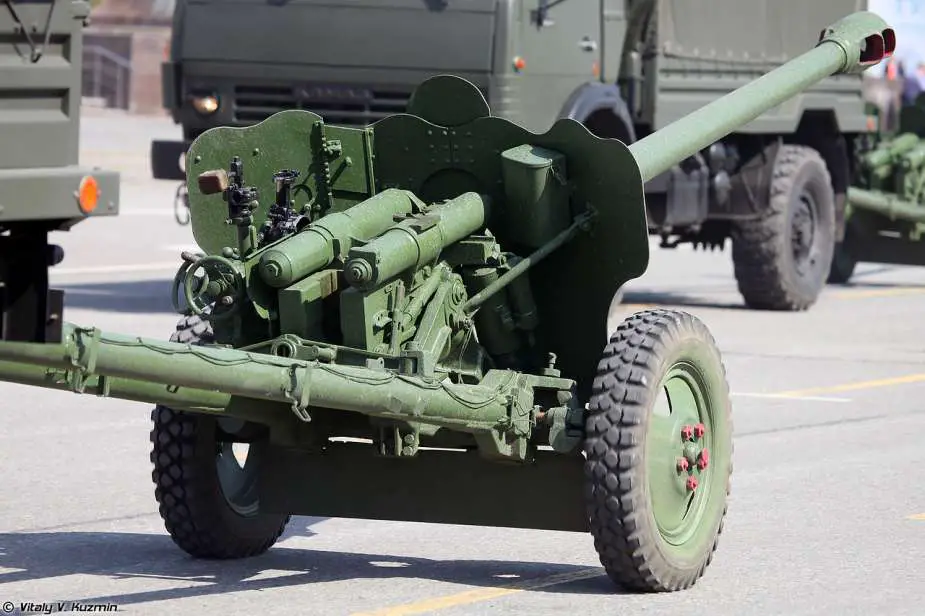- Army
- Conflicts in the world
- Israel - Iran conflict 2025
- Pakistan - India Conflict 2025
- Russia Ukraine War 2022
- Libya conflict day by day
- HAMAS - Israel War 2023
- Operation Serval in Mali French Army
- Sangaris operation Central African Republic
- Sangaris opération militaire République Centreafrique
- Ukraine - Russia conflict
- Syria conflict news
- Defence & Security Industry Technology
- Armies in the world
- Analysis Defense and Security Industry
- Conflicts in the world
- Navy
- Air
Russian World War 2-era D-44 howitzer destroyed by Ukrainian drone
In a tweet dated September 27, 2023, from The Dead District account, the footage shows a UAV taking down a World War 2-era D-44 howitzer. This Stalin-era towed gun is still in operation among Russian forces, highlighting the use of equipment dating back to 1944.
Follow Army Recognition on Google News at this link

D-44 howitzer dating back to WW2 in service in Russian forces in Ukraine (Picture source: Video footage from the Twitter account of The Dead District )
Despite Russia's pre-war artillery arsenal being more than double that of Ukraine, the imbalance in losses is glaring. The trend suggests an unfavorable trajectory for Russian forces, who are increasingly relying on outdated artillery systems, as evidenced here with the D-44 artillery piece.
Recently, a Ukrainian drone operator, Robert Brovdi, released footage of a drone strike that took out a Russian D-44 field gun, a relic designed in 1943 and produced in 1944. This is not the first time the 85-millimeter D-44 has made an appearance in the ongoing conflict. Ukrainian forces have even retrofitted this antique artillery piece onto 1970s-era MT-LB armored tractors, creating a unique tank-destroying unit known as the MT-LB-44.
The presence of such an outdated artillery piece in the Russian arsenal underscores the extent of Russia's artillery losses and their scramble to compensate for them. The D-44, once mass-produced by the Soviet Union’s Uralmash factory between 1944 and 1953, had been largely phased out in favor of the more potent D-30 since the early 1980s.
With 10,800 units built, the D-44 has been a part of various wars, from the Vietnam War and the Lebanese Civil War to the Iran-Iraq War, the First Nagorno-Karabakh War, the War in Donbas, the 2020 Nagorno-Karabakh conflict, and most recently, the 2022 Russian invasion of Ukraine.
The D-44 is a robust piece of artillery, weighing in at 1,725 kg. Its heavier variant, the SD-44, tips the scales at 2,250 kg. The gun stretches 8.34 meters in length, with a barrel length of 4.7 meters, or 55 calibers. It has a width of 1.78 meters and stands 1.42 meters tall. The gun requires a crew of eight to operate efficiently.
The D-44 uses a fixed QF 85×629 mm shell with a caliber of 85 mm. The gun employs a semi-automatic vertical sliding-wedge breech and a hydro-pneumatic recoil system. Its carriage is of the split-trail type, allowing for an elevation range of -7° to 35° and a traverse of 54°.
It can fire up to 20 rounds per minute in burst mode. The gun has an effective firing range of 1,150 meters when using HVAP-T ammunition, and its maximum firing range extends to 15.65 km. The D-44 is equipped with OP-2-7 sights that offer 5.5X magnification.
Over the years, the D-44 has seen various modifications and adaptations, including the D-44N and SD-44 variants, as well as the Chinese Type 56. Despite its age and the advent of more modern artillery systems, the D-44 continues to see action on various fronts. Its recent appearance in the 2022 Russian invasion of Ukraine serves as a testament to its durability and adaptability, even as it becomes a symbol of the challenges faced by armies increasingly reliant on outdated hardware.
While the destruction of a single, outdated Russian D-44 field gun may not significantly shift the artillery balance, it perhaps indicates the availability of artillery pieces within the Russian armed forces.
 Russian D-44 howitzer dating back to World War 2 but still in use (Picture source: Vitaly V.Kuzmin)
Russian D-44 howitzer dating back to World War 2 but still in use (Picture source: Vitaly V.Kuzmin)


























